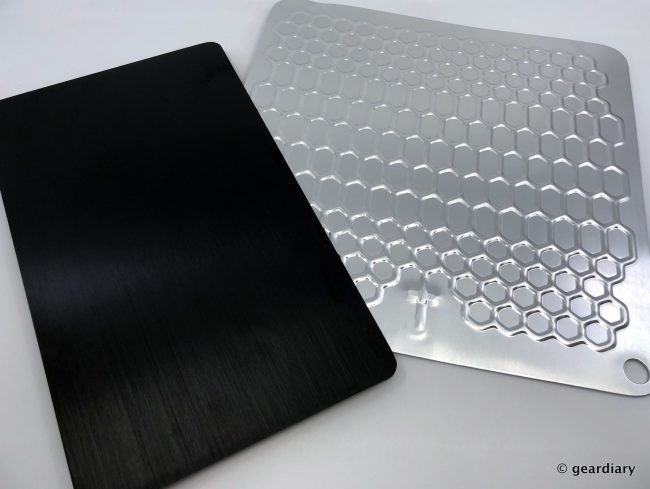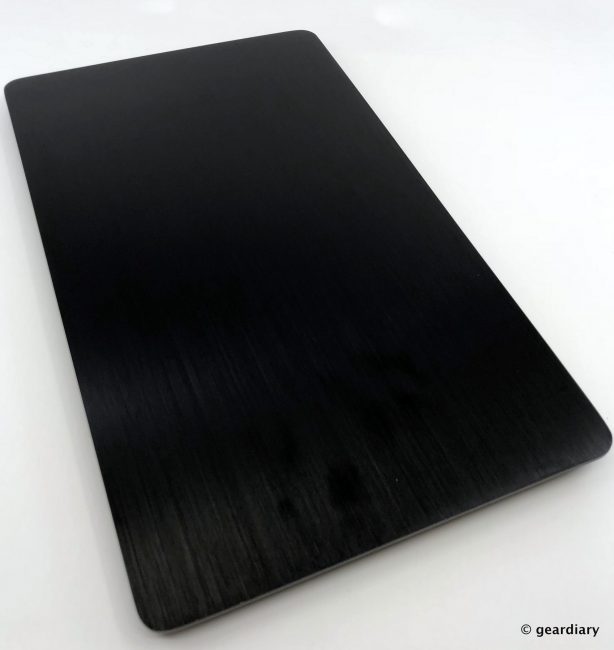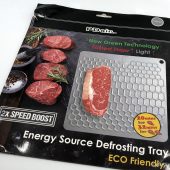
Using a slab of aluminum to more quickly defrost your frozen meats is nothing new, yet it’s not something that many of us think to do. PDAir sent me a couple of their Energy Source Defrosting Trays to try. Two different styles; each has its own merits. Let’s take a look.
Aluminum defrosting trays operate as a heat sink: to use them effectively, you place your frozen, unwrapped meat on their clean surface, and as long as the item you’ve placed on the defrosting tray isn’t too large (or too thick), the cold is soon dispersed to the metal, and the meat is able to thaw in a fraction of the usual time.
It’s worth pointing out that the USDA only recommends four methods for safely thawing meat; those methods include: refrigerator thawing (great when you’ve planned ahead); cold water thawing (which may or may not allow water to get on your meat, gross), microwave thawing (which can sometimes make the meat pre-cook a bit more than you’d like in odd places), and cooking without thawing (which takes about 50% more time to do). The USDA also says that “Perishable foods should never be thawed on the counter or in hot water and must not be left at room temperature for more than two hours.” [their emphasis]
I’m going to admit here and now that I don’t always remember to put the meat we’ll be eating the next day in the fridge so that it will be defrosted when needed; I’ve totally been guilty of putting a frozen, wrapped tray of steaks or chicken on the counter around noon (on the day they’d be needed) and hoping the meat would be defrosted (or at least usable) by the time we’re ready to cook it — around 5:30 or 6 pm. Kev will usually come in around 3 pm and break the still semi-frozen meat apart, transferring it to the disposable aluminum pans that he likes to use when grilling so he can season it and allow it to finish thawing. While this isn’t technically safe food handling, Kev does make sure that any steaks which are cooked are properly seared on the outside and the chicken is thoroughly cooked. We’ve never had any issues, but that doesn’t mean it’s necessarily safe; it’s also something that I suspect a lot more people do than one might guess. On days like that, a defrosting tray can sure be handy.
PDAir sells two defrosting tray styles; one is for simply defrosting meat more quickly, and the other will defrost meat, but it can also be chilled and then used to hold cold items (like cheese) for serving. Cleanup for both trays is simple: hot soapy water and a sponge; never put them in a dishwasher, and don’t use sharp knives on them.
PDAir Energy Source Aluminum Defrosting Trays Features
• Dissipates cold and draws ambient warmth to the surface
• Eco-Friendly – No Electricity required
• PCI Aircraft Aluminum Operation Mechanism
• Cleaner than soaking
• Gentler than microwaving
• Faster (up to 4x) than traditional countertop thawing
• Easy to Wash
Energy Source ES Defrosting Tray
The Energy Source Defrosting Tray measures 11.8? wide by 11.8? tall by 0.1? thick, and it weighs 13.9 ounces. It’s essentially a thin slab of PCI Aircraft Aluminum with a raised honeycomb pattern on both sides. The honeycomb pattern helps diffuse the cold to the metal. PDAir says the tray works because of “Phase Change Inhibited (PCI) Heat Transfer Technology”, which they say “combines high heat transport speed and high heat flux by Built-in Conduit Pipe system into an aluminum plate, using the fluid which is the commercial secret to carry heat in a pipe. This New Technology has a special operation mechanism to speed up 20x heat dissipation rate and thaw food quickly (up to 3x) comparing to traditional or general aluminum plate.” In layman’s terms, the honeycomb design helps the meat thaw more quickly as the cold transfers to the larger metal surface.

My tray got a little bit bent during shipping, but it’s still fully functional.
To use the defrosting tray, you simply place the meat you’re trying to thaw on its clean surface, and you let it sit there for up to 30 minutes while it thaws. You can cover the meat and tray with saran wrap or tin foil, if you’d like, and depending on what you’re thawing, the meat should be usable soon. Note that I say usable — the frozen meat will likely not be fully thawed, but it’s to the point that it can be cooked with almost normal cooking times and no real extra wait.
While the defrosting tray does cut defrosting time down quite a bit, it’s not miraculous; you do need to make sure that you’ve got more tray than product needing thawing, and you can’t leave a stack of frozen steaks on it expecting them to thaw enough to cook in even an hour; it doesn’t work that way. However, if you have up to four reasonably sized steaks or chicken breasts to thaw, and you lay them out on the tray, they will be thawed enough to use in around 30 minutes.
But bear in mind that you are still thawing food on your kitchen counter, and the USDA strongly recommends against that.
Energy Source Defrosting Tray + Chill Platter
This little tray is my favorite. It’s perfect for thawing a couple of steaks or chicken breasts, and it looks nice while doing it. Measuring 11.8? long by 7.1? wide by 0.55? thick and weighing 22 ounces, it has a black brushed aluminum finish on top.

On the underside, there are four rubber feet that raise the defrosting tray off the table, and you can see the cold-diffusing honeycomb pattern again.

This tray defrosts in similar amounts of time, but it also has a secondary trick: It can serve as a chill plate for cold foods. If you are setting out cheese or fruit for a party, you can place the tray in the freezer for 10 – 15 minutes, it will keep the chilled food placed on it cold for up to 30 minutes and cool for a bit longer. Just remember to prep the food that will be kept on it before transferring it to the chill plate, as you can’t use a knife on its surface.
As long as you follow a few simple food-safety guidelines, the PDAir Energy Source Aluminum Defrosting Trays can be a valuable addition to your kitchen. So keep the following things in mind before and as you use them:
• Always wash in hot soapy water with a sponge (I do this before and after using)
• Don’t leave your food on the counter for hours; up to 30 minutes should be sufficient to get your frozen food to a thawed enough state that it can be easily cooked
But even so, you are still defrosting food on the counter, and the USDA says we shouldn’t do it. I know that there must be a guy or gal sitting in a USDA office somewhere, banging his head on his desk about the fact that in 2018 people are still thawing meat on their counters, but it’s a thing. A lot of us do it. The PDAir defrosting trays help you do it more quickly.
I’m curious to know if any of you have any horror stories about countertop defrosting (with or without . defrosting tray). I don’t, but I’m guessing some of you might?
The PDAir Energy Source Aluminum Defrosting Trays retail for $29.99 for the larger flat version and $43.99 for the smaller version with feet.
Source: Manufacturer supplied review sample
What I Like: Attractive design (especially on the smaller tray); They really do help thaw your meats more quickly; Easy to clean; The smaller tray can also be used to chill cold foods
What Needs Improvement: You’re still defrosting food on your counter, and the USDA says that isn’t safe




